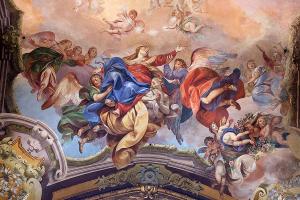
What's the Assumption, anyway? A CNA Explainer
FREE Catholic Classes
On Aug. 15, Catholics around the world mark the Feast of the Assumption of Mary, commemorating the end of her earthly life and assumption into Heaven.

Highlights
Washington D.C., (CNA) - But while the feast day is a relatively new one, the history of the holiday " and the mystery behind it " has its roots in the earliest centuries of Christian belief.
The Catholic Church teaches that when Mary ended her earthly life, God assumed her, body and soul into heaven.
The dogma of the Assumption of Mary " also called the "Dormition of Mary" in the Eastern Churches " has its roots in the early centuries of the Church.
While a site outside of Jerusalem was recognized as the tomb of Mary, the earliest Christians maintained that "no one was there," theologian and EWTN senior contributor Matthew Bunson told CNA.
According to St. John of Damascus, the Roman emperor Marcian requested the body of Mary, Mother of God at the Council of Chalcedon, in 451.
St. Juvenal, who was Bishop of Jerusalem told the emperor "that Mary died in the presence of all the Apostles, but that her tomb, when opened upon the request of St. Thomas, was found empty; wherefrom the Apostles concluded that the body was taken up to heaven," the saint recorded.
By the 8th century, around the time of Pope Adrian, the Church began to change its terminology, renaming the feast day of the Memorial of Mary to the Assumption of Mary, Bunson noted.
The belief in the Assumption of Mary was a widely-held tradition, and a frequent meditation in the writings of saints throughout the centuries. However it was not defined officially until the past century.
In 1950, Pope Pius XII made an infallible, ex-cathedra statement in the Apostolic Constitution Munificentissimus deus officially defining the dogma of the Assumption.
"By the authority of our Lord Jesus Christ, of the Blessed Apostles Peter and Paul, and by our own authority, we pronounce, declare, and define it to be a divinely revealed dogma: that the Immaculate Mother of God, the ever Virgin Mary, having completed the course of her earthly life, was assumed body and soul into heavenly glory," the pope wrote.
The decree was seen as the formalizing of long-held Christian teaching.
"We have throughout the history of the Church an almost universal attestation of this," Bunson said of the Assumption.
"We have this thread that runs throughout the whole of the history of the Church in support of the dogma. That's significant because it supports the tradition of the Church, but it also supports a coming to a deeper understanding of the teachings of the Church of how we rely upon the reflections of some of the greatest minds of our Church."
What's also notable about the dogma, he added, is that it "uses the passive tense," emphasizing that Mary did not ascend into heaven on her own power, as Christ did, but was raised into heaven by God's grace.
Today, the Feast of the Assumption is marked as a major feast day and a public holiday in many countries. In most countries, including the United States, it is a Holy Day of Obligation, and Catholics are required to attend Mass.
Bunson explained that on major feast days, it's important to mark the significance of the feast as especially vital by emphasizing the necessity of celebrating the Eucharist that day.
"What is more fitting than on the Assumption of the Blessed Mother to, once again, focus on her Son, on the Eucharist?" he asked.
A version of this article was originally published on CNA Aug. 15, 2017.
---
'Help Give every Student and Teacher FREE resources for a world-class Moral Catholic Education'
Copyright 2021 - Distributed by Catholic Online
Join the Movement
When you sign up below, you don't just join an email list - you're joining an entire movement for Free world class Catholic education.
An Urgent Message from Sister Sara – Please Watch
- Advent / Christmas
- 7 Morning Prayers
- Mysteries of the Rosary
- Litany of the Bl. Virgin Mary
- Popular Saints
- Popular Prayers
- Female Saints
- Saint Feast Days by Month
- Stations of the Cross
- St. Francis of Assisi
- St. Michael the Archangel
- The Apostles' Creed
- Unfailing Prayer to St. Anthony
- Pray the Rosary
![]()
Copyright 2026 Catholic Online. All materials contained on this site, whether written, audible or visual are the exclusive property of Catholic Online and are protected under U.S. and International copyright laws, © Copyright 2026 Catholic Online. Any unauthorized use, without prior written consent of Catholic Online is strictly forbidden and prohibited.
Catholic Online is a Project of Your Catholic Voice Foundation, a Not-for-Profit Corporation. Your Catholic Voice Foundation has been granted a recognition of tax exemption under Section 501(c)(3) of the Internal Revenue Code. Federal Tax Identification Number: 81-0596847. Your gift is tax-deductible as allowed by law.








